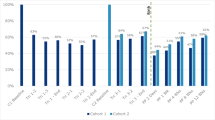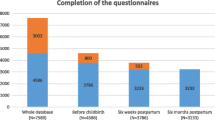Abstract
Objective: This study identified correlates of self-reports of being very depressed in the months after delivery in a population-based sample of women. Methods: We analyzed data on 14,609 recent mothers from the Centers for Disease Control and Prevention's (CDC) Pregnancy Risk Assessment Monitoring System (PRAMS). The sample included mothers who delivered a live birth in Colorado, New York State, and North Carolina from 1996 (New York only) to 1999. We assessed risk factors for self-reports of being very depressed in the months after delivery using logistic regression. Results: Overall, 5.9% (95% CI = 5.3, 6.4) of new mothers reported being very depressed in the months after delivery. Women who reported that their pregnancy was a “very hard time” or “one of the worst times of my life” had the highest prevalence of reporting being very depressed in the months after delivery (24.9%, 95% CI = 21.3, 28.5) and, when all risk factors were adjusted for simultaneously, were 4.6 times (95% CI = 3.1, 6.3) more likely to report being very depressed in the months after delivery than other women. Other significant risk factors for self-reports of being very depressed in the months after delivery included experiencing partner-associated stress (OR = 1.9, 95% CI = 1.5, 2.5), physical abuse during pregnancy (OR = 1.6, 95% CI = 1.1, 2.4), and not breast-feeding (OR = 1.4, 95% CI = 1.1, 1.8). Conclusions: The highest prevalence for self-reports of being very depressed in the months after delivery was in women who reported that their pregnancy was a “very hard time” or “one of the worst times of my life.” Clinicians need to be aware of the needs of some women for mental health services both during and after pregnancy.
Similar content being viewed by others
REFERENCES
Beck CT. The effects of postpartum depression on maternal-infant interaction:Ameta-analysis. Nurs Res 1995;44:298–304.
Campbell SB, Cohn JF. Prevalence and correlates of postpartum depression in first-time mothers. J Abnorm Psychol 1991;100:594–9.
Cooper PJ, Campbell EA, Day A, Kennerley H, Bond A. Nonpsychotic psychiatric disorder after childbirth: A prospective study of prevalence, incidence, course and nature. Br J Psychiatry 1988;152:799–806.
Field T. Infants of depressed mothers. Dev Psychopathol 1992;4:49–66.
Gotlib IH, Whiffen VE, Wallace PM, Mount JH. Prospective investigation of postpartum depression: Factors involved in onset and recovery. J Abnorm Psychol 1991;100:122–32.
Kumar R, Robson KM. A prospective study of emotional disorders in childbearing women. Br J Psychiatry 1984;144:35–47.
Philipps LH, O'Hara MW. Prospective study of postpartum depression: 4\(\frac{1}{2}\)-year follow-up of women and children. J Abnorm Psychol 1991;100:151–5.
Robinson GE, Olmsted MP, Garner DM. Predictors of postpartum adjustment. Acta Psychiatr Scand 1989;80:561–5.
Gotlib IH, Whiffen VE, Mount JH, Cordy NI. Prevalence rates and demographic characteristics associated with depression in pregnancy and the postpartum. J Consult Clin Psychol 1989;57:269–74.
Herrick H. The effect of stressful life events on postpartum depression: Results from the 1997–1998 North Carolina Pregnancy Risk Assessment Monitoring System (PRAMS). SCHS Stud 2000;121:1–9.
Hobfoll SE, Ritter C, Lavin J, Hulsizer MR, Cameron RP. Depression prevalence and incidence among inner-city pregnant and postpartum women. J Consult Clin Psychol 1995;63:445–53.
McGill H, Burrows VL, Holland LA, Langer HJ, Sweet MA. Postnatal depression: A Christchurch study. N Z Med J 1995;108:162–5.
Pop VJ, Essed GG, de Geus CA, van Som MM, Kromproe IH. Prevalence of postpartum depression or is it postpuerium depression? Acta Obstet Gynecol Scand 1993;72:354–8.
Warner R, Appleby L, Whitton A, Faragher B. Demographic and obstetric risk factors for postnatal psychiatric morbidity. Br J Psychiatry 1996;168:607–11.
Yonkers KA, Ramin SM, Rush AJ, Navarrete CA, Carmody T, March D, Heartwell SF, Leveno KJ. Onset and persistence of postpartum depression in an inner-city maternal health clinic system. Am J Psychiatry 2001;158:1856–63.
Lane A, Keville R, Morris M, Kinsella A, Turner M, Barry S. Postnatal depression and elation among mothers and their partners: Prevalence and predictors. Br J Psychiatry 1997;171:550–5.
Johnstone SJ, Boyce PM, Hickey AR, Morris-Yates AD, Harris MG. Obstetric risk factors for postnatal depression in urban and rural community samples. Aust N Z J Psychiatry 2001;35:69–74.
O'Hara MW, Swain AM. Rates and risk of postpartum depression-A meta-analysis. Int Rev Psychiatry 1996;8:37–54.
McLennan JD, Kotelchuck M, Cho H. Prevalence, persistence and correlates of depressive symptoms in a national sample of mothers of toddlers. J Am Acad Child Adolesc Psychiatry 2001; 40:1316–23.
Ahluwalia IB, Merritt R, Beck LF, Rogers M. Multiple lifestyle and psychosocial risks and delivery of small for gestational age infants. Obstet Gynecol 2000;97:649–56.
O'Hara MW, Schlechte AJ, Lewis DA, Varner MW. Controlled prospective study of postpartum mood disorders: Psychological, environmental, and hormonal variables. J Abnormal Psychol 1991;100:63–73.
Coker AL, Pope BO, Smith PH, Sanderson M, Hussey JR. Assessment of clinical partner violence screening tools. J Am Med Womens Assoc 2001;56:19–23.
Scholle SH, Rost KM, Golding JM. Physical abuse among depressed women. J Gen Intern Med 1998;13:607–13.
Evans J, Heron J, Francomb H, Oke S, Golding J. Cohort study of depressed mood during pregnancy and after childbirth. BMJ 2001;323:257–60.
Stein G. The pattern of mental change and body weight change in the first post-partum week. J Psychosom Res 1980;24:165–71.
American Psychiatric Association. Diagnostic and statistical manual of mental disorders: DSM IV. Washington, DC: American Psychiatric Press, 1994.
Appleby L, Warner R, Whitton A, Faragher B. A controlled study of fluoxetine and cognitive-behavioral counseling in the treatment of postnatal depression. BMJ 1997;314:932–6.
O'Hara MW, Scott S, Gorman L, Wenzel A. Efficacy of interpersonal psychotherapy for postpartum depression. Arch Gen Psychiatry 2000;57:1039–45.
Suri R, Burt V, Altshuler LL, Zuckerbrow-Miller J, Fairbanks L. Fluvoxamine for postpartum depression. Am J Psychiatry 2001;158:1739–40.
Zlotnick C, Johnson S, Miller I, Pearlstein T, Howard M. Postpartum depression in women receiving public assistance: Pilot study of an interpersonal-therapy-oriented group intervention. Am J Psychiatry 2001;158:638–40.
Author information
Authors and Affiliations
Rights and permissions
About this article
Cite this article
Gross, K.H., Wells, C.S., Radigan-Garcia, A. et al. Correlates of Self-Reports of Being Very Depressed in the Months After Delivery: Results from the Pregnancy Risk Assessment Monitoring System. Matern Child Health J 6, 247–253 (2002). https://doi.org/10.1023/A:1021110100339
Issue Date:
DOI: https://doi.org/10.1023/A:1021110100339




